The virtual reality classroom: Engaging students and communities in collaborative learning with virtual reality to understand disasters and climate change
This publication refers to an initiative aimed at improving people's awareness and knowledge of landslides and their risks. 360-degree and aerial images of landslides in Bajhang and Bajura districts in Nepal were used to create virtual reality (VR) content packaged into web and mobile applications for the Meta Oculus Quest 2 VR platform, customized with embedded awareness and adaptation measures. The initiative was then implemented in four districts: Bajhang, Bajura, Doti, and Kanchanpur in the Sudurpaschim Province of Nepal.
Over 500 students and teachers from two public schools in Bajhang and Bajura, as well as 40 community representatives from the four districts, participated in the training sessions organized in these districts. The sessions, featuring VR simulations and practical exercises, provided participants with a deeper understanding of landslides and their risk-reduction strategies. The pilot initiative demonstrated the potential of VR technology to deliver innovative educational content, helping communities better understand and mitigate disaster risks.
Explore further
